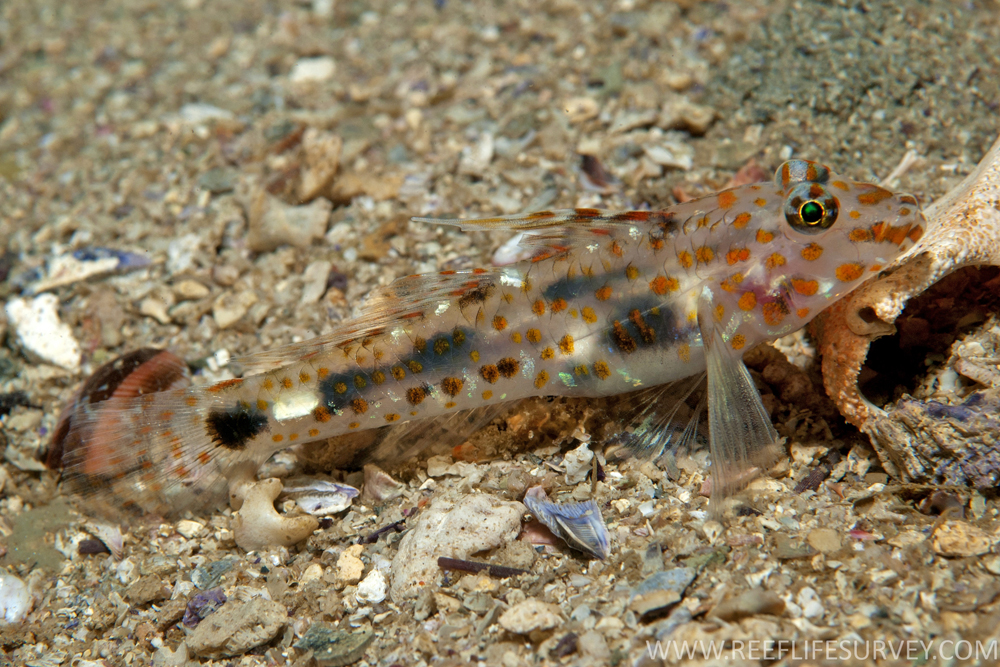- Classification
- ACTINOPTERYGII
- PERCIFORMES
- GOBIIDAE
- Fusigobius
- inframaculatus
Innerspot Sandgoby, Fusigobius inframaculatus (Randall 1994)
Other Names: Blotched Sand Goby, Flasher Goby, Innerspotted Sandgoby, Orange-spotted Sand Goby, Orange-spotted Sand-goby

An Innerspot Sandgoby, Fusigobius inframaculatus, at North West Solitary Island, New South Wales. Source: Ian V. Shaw / Reef Life Survey. License: CC by Attribution
Summary:
A semi-transparent goby covered in small gold to orange spots, with 4-5 blackish internal blotches, a black blotch on the caudal peduncle and several rectangular white markings. The first two dorsal-fin spines are filamentous, especially in males.
Cite this page as:
Bray, D.J. 2022, Fusigobius inframaculatus in Fishes of Australia, accessed 27 Jun 2025, https://fishesofaustralia.net.au/home/species/121
Innerspot Sandgoby, Fusigobius inframaculatus (Randall 1994)
More Info
|
Distribution |
Houtman Abrolhos to Cassini Island, Western Australia, and the far northern Great Barrier Reef, Queensland, to the Solitary Islands, New South Wales; also the Lord Howe Province in the Tasman Sea. Elsewhere, the species occurs in the tropical, Indo-west Pacific. Inhabits sandy and coral rubble areas in coastal waters, often at the base of coral overhangs. |
|
Features |
Dorsal fin VI + I, 9; anal fin I, 7-8; Pectoral fin 17-20; Longitudinal scale series 25-26. Body depth 4.8-5.2 in SL. First two dorsal-fin spines filamentous, especially in males; pelvic fins fully united; pelvic frenum present; gill opening extending to below posterior half of operculum. Scales mostly ctenoid except cycloid on nape, breast and pectoral-fin base; scales on side of nape extending to level of eyes; median predorsal scales absent. |
|
Biology |
Forms spawning pairs that nuture the egg clusters. |
|
Etymology |
The specific name inframaculatus is from the Latin infra- (= inner) and maculatus (= spotted) in reference to the elongate internal black-and-white spots (or dashes). |
|
Species Citation |
Coryphopterus inframaculatus Randall, 1994, Fauna of Saudi Arabia 14: 331, fig. 3, pls 12-13. Type locality: base of drop off, northeastern side of Jana Island, Persian Gulf, Saudi Arabia, depth 15 m. |
|
Author |
Bray, D.J. 2022 |
|
Resources |
Innerspot Sandgoby, Fusigobius inframaculatus (Randall 1994)
References
Allen, G.R. & Erdmann, M.V. 2012. Reef fishes of the East Indies. Perth : Tropical Reef Research 3 vols, 1260 pp.
Coleman, N. 1981. Australian Sea Fishes North of 30°S. Lane Cove, NSW : Doubleday Australia Pty Ltd 297 pp.
Johnson, J.W. 2010. Fishes of the Moreton Bay Marine Park and adjacent continental shelf waters, Queensland, Australia. pp. 299-353 in Davie, P.J.F. & Phillips, J.A. Proceedings of the Thirteenth International Marine Biological Workshop, The Marine Fauna and Flora of Moreton Bay. Memoirs of the Queensland Museum 54(3)
Kuiter, R.H. 1992. Tropical Reef-Fishes of the Western Pacific, Indonesia and Adjacent Waters. Jakarta : PT Gramedia Pustaka Utama 314 pp. pls.
Kuiter, R.H. 1996. Guide to Sea Fishes of Australia. A comprehensive reference for divers and fishermen. Sydney, NSW, Australia : New Holland Publishers xvii, 434 pp.
Larson, H. 2019. Fusigobius inframaculatus. The IUCN Red List of Threatened Species 2019: e.T193218A2210415. https://dx.doi.org/10.2305/IUCN.UK.2019-3.RLTS.T193218A2210415.en. Accessed on 23 June 2022.
Randall, J.E. 1994. A new genus and six new gobiid fishes (Perciformes: Gobiidae) from Arabian waters. Fauna of Saudi Arabia 14: 317-340 figs 1-3 pls 1-16
Randall, J.E., 2005. Reef and shore fishes of the South Pacific. New Caledonia to Tahiti and the Pitcairn Islands. University of Hawaii Press, Honolulu, Hawaii. 720 pp.
Randall, J.E., Allen, G.R. & Steene, R. 1990. Fishes of the Great Barrier Reef and Coral Sea. Bathurst : Crawford House Press 507 pp. figs.
Randall, J.E., Allen, G.R. & Steene, R. 1997. Fishes of the Great Barrier Reef and Coral Sea. Bathurst : Crawford House Press 557 pp. figs. (as Coryphopterus sp.)
Thacker, C.E. & Cole, K.E. 2002. Phylogeny and evolution of the gobiid genus Coryphopterus. Bulletin of Marine Science 70(3): 837-850.










